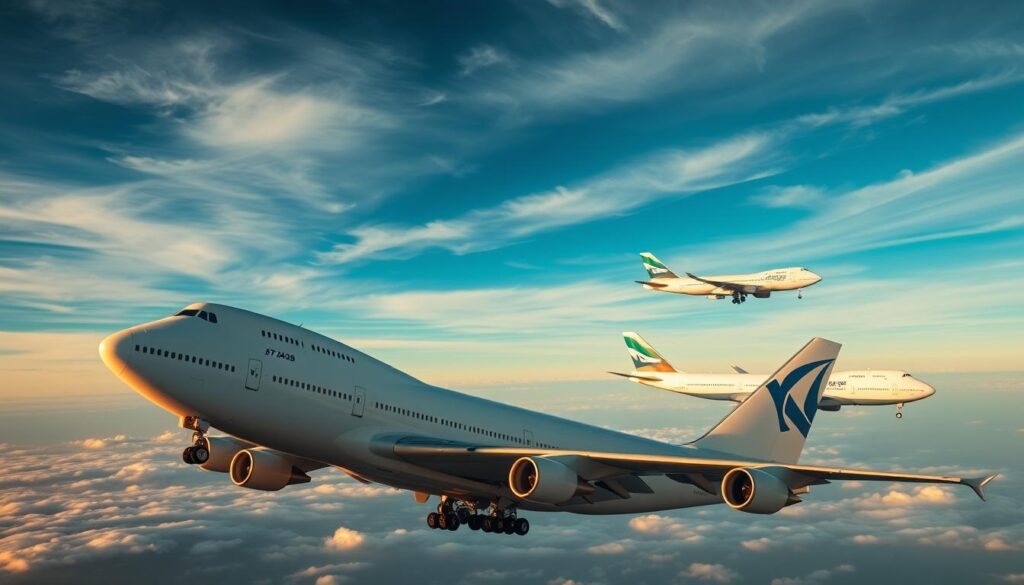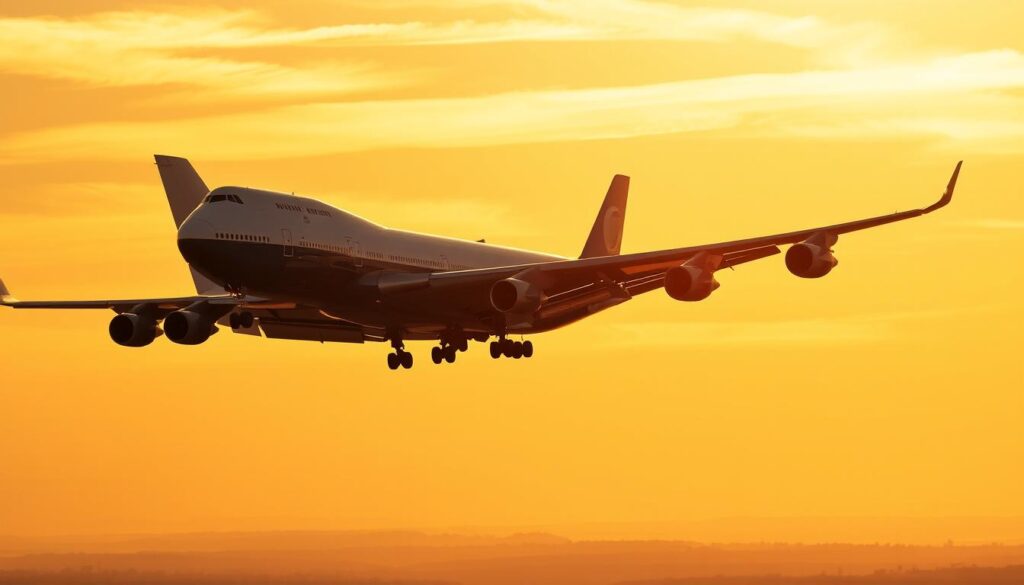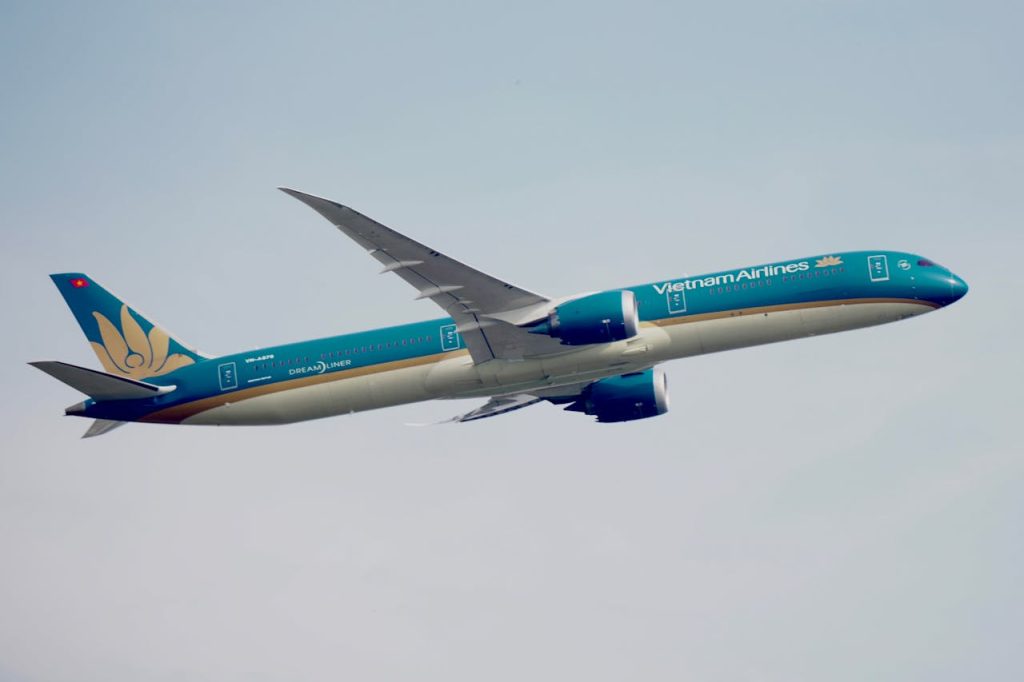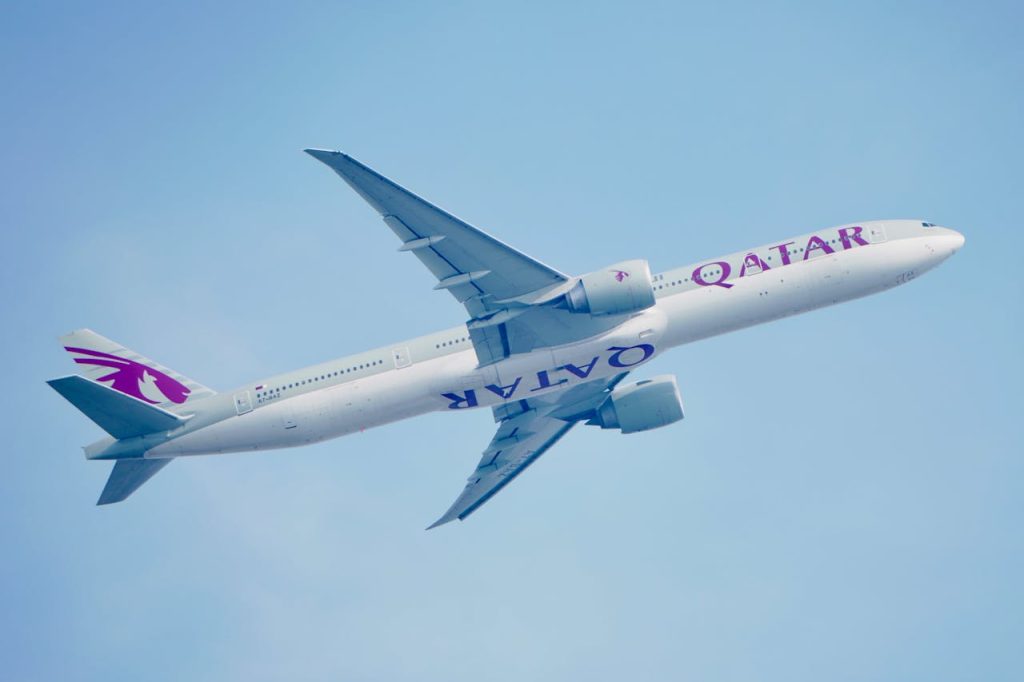Did you know the Boeing 747 family has flown over 3.5 billion passengers since 1969? This amazing number highlights how the Boeing 747SR, a special type of this iconic plane, has changed global aviation. With its huge size and cool engineering, this jumbo jet has not just changed travel. It has also transformed the logistics industry, changing how we see air transportation. In this article, we’re going to look at the amazing features, important history, and special things about the Boeing 747SR. We’ll see why it’s still so respected in the sky.
Key Takeaways
- The Boeing 747SR is a significant variant in the Boeing 747 family.
- Astonishingly, over 3.5 billion passengers have flown on Boeing 747s since 1969.
- This jumbo jet is often hailed as the “Queen of the Skies.”
- The Boeing 747SR played a pivotal role in transforming air travel.
- We will delve into the specifications and history of this iconic aircraft.
Introduction to the Boeing 747 Family
The Boeing 747 family marks a huge step in commercial aviation and the history of Boeing 747. When the first 747-100 took off in January 1970, it started a new air travel era. It could hold two and a half times more passengers than the Boeing 707, starting the age of jumbo jets.
The Boeing 747 has seen many innovations over the years. It now includes models like the 747-200, 747-400, and the new 747-8. Each new version improved in performance, range, and technology. This made the 747 a leader in commercial aviation.
Overview of the Boeing 747 Development Timeline
| Model | Year Introduced | Significant Features |
|---|---|---|
| 747-100 | 1970 | First model; revolutionized air travel capacity |
| 747-200 | 1971 | Upgraded engines for increased takeoff weight |
| 747-400 | 1989 | New glass cockpit and advanced engines |
| 747-8 | 2012 | Latest technology with enhanced fuel efficiency |
Big airlines like Pan Am, KLM, and Lufthansa chose these models, making the Boeing 747 key in global flights. For deeper details on the history of Boeing 747, check out more information here.
Historical Background of the Boeing 747SR
The Boeing 747SR was made to fit Japan’s busy skies. It was a big deal for the Boeing 747 family. Created in the early 1970s, it was perfect for short trips with lots of passengers.
Japan Airlines was first to use it, aiming for fast flights and quick boarding. This plane was a tweaked Boeing 747-100, built for the booming 1970s. Then, flying became something everyone could do.
This version showed how the Boeing 747SR history kept evolving. When it first flew with Japan Airlines in 1973, it changed air travel in Asia. The Boeing 747SR turned into a key player for reliable and quick flights.
| Year | Event |
|---|---|
| 1970 | Launch of the Boeing 747 family |
| 1973 | First flight of the Boeing 747SR with Japan Airlines |
| 1970s | Surge in domestic air travel in Japan |
| 1980 | Continued success and evolution of the Boeing 747 series |
Boeing 747SR Specifications
The Boeing 747SR is a standout in aviation due to its impressive design and specs. It’s important to understand these specs to know how it performs and what it’s used for. In the following text, we’ll look into the 747SR’s technical details and what makes it special.
Technical Specifications
| Specification | Details |
|---|---|
| Maximum Takeoff Weight | 735,000 lbs (333,000 kg) |
| Wingspan | 196.5 ft (60 m) |
| Overall Length | 231 ft (70.6 m) |
| Powerplant | Pratt & Whitney JT9D turbofan engines |
| Passenger Capacity | Approximately 500 (all-economy configuration) |
Performance Features
The Boeing 747SR has amazing performance that makes it great for short flights. It can fly at Mach 0.85, or about 490 knots (900 km/h). This plane can go about 4,600 nautical miles (8,500 km), connecting big local places easily. Plus, its design helps it take off from shorter runways.
Notable Variants of the Boeing 747
The Boeing 747 family has many unique versions. Each one is designed to meet different needs and uses. They have changed over time to fit what the market and operations require.
The first model was the 747-100, changing air travel forever when it was introduced. The 747SR followed, made for domestic flights with lots of seats. It helped airlines improve their operations on shorter trips.
Then came the 747-200, with better engines and the ability to carry more. The 747-400 brought newer technology, like a glass cockpit for two people and modern flying systems. This made flying safer and operations smoother.
The Boeing 747-8 is the newest model, with updated engines and a larger wingspan. It shows how the Boeing 747 line focuses on saving fuel and meeting today’s travel needs.
There are also 747s made for carrying cargo and for military use. For example, the VC-25, known as Air Force One, and the E-4B Nightwatch, show how flexible the 747 can be.

Production Years of the Boeing 747SR
The Boeing 747SR’s journey began in the early 1970s and ended in 1982. This era was key for the Boeing 747 family because the 747SR was designed specially for Japan. It first flew in 1975 and started serving passengers the same year.
About 60 Boeing 747SR planes were made, showing Boeing’s commitment to meeting specific needs. The 747SR met the growing need for short flights, showing Boeing understood what travelers wanted. People often remember this model fondly for how it changed flying.
The Role of the Boeing 747SR in Aviation
The Boeing 747SR changed commercial flying, especially in Asia. It let airlines carry more people on domestic flights without huge costs. This plane led to more air travel in the 1970s.
This plane made a big difference in commercial flying. It met the growing needs of both business and fun travel. This helped tourism grow. It made traveling something everyone could do, changing the history of flying.
The Boeing 747SR did more than just fly people around; it changed the future. It made airlines think about different kinds of trips people wanted to take. This thinking led to new planes. These planes made flying better for everyone and helped airlines work better.
Boeing 747SR Dimensions
The Boeing 747SR is known as a giant in aviation. Its size shows us the amazing engineering involved. We learn its abilities for carrying passengers or cargo by looking at its specs.
Overall Aircraft Dimensions
The Boeing 747SR has a huge wingspan, reaching 196.5 feet, and stretches about 231 feet long. It stands 63.7 feet tall. These numbers show why it’s among the biggest in commercial flight history.
Passenger and Cargo Capacity
This aircraft can hold around 500 passengers in an economy setup. That makes it perfect for busy, short flights inside a country. Besides carrying passengers, it can haul a lot of cargo too. This proves how essential the Boeing 747SR is for moving people and goods.
Current Availability of Boeing 747SR for Sale
The availability of the Boeing 747SR for sale is quite limited nowadays. Many airlines are choosing newer, more eco-friendly planes. This trend has reduced the demand for big passenger jets like the Boeing 747SR.
However, those interested can still find this iconic aircraft. It’s possible through specialized aviation brokers and online sales platforms. Usually, these planes were once flown by major airlines. Buyers looking into a Boeing 747SR need to consider refurbishment costs. They should also think about operational capacity due to the plane’s unique features.

For those eyeing the current market, understanding its complexities is key. The Boeing 747SR’s special qualities mean thorough checks are important. Paying close attention to its condition and maintenance history is vital for buyers.
Legacy and Impact of the Boeing 747SR
The Boeing 747SR’s legacy is huge in aviation history. This plane was key in changing the impact on aviation industry. Its new design and efficient use changed how future planes were made. It could carry lots of passengers far, setting high standards for others to follow.
Its historical significance in making air travel better is well-known. It helped cities across great distances connect better. The Boeing 747SR also boosted passenger numbers and led to bigger airline networks, especially in Asia. This made travel easier for many people.
To many, the Boeing 747SR shows progress in flying. It keeps inspiring those who make and operate planes, pushing for better design, technology, and eco-friendly solutions. Its influence will be felt in aviation for a long time.
Conclusion
This Boeing 747SR summary highlights a major shift in aviation technology. Its unique design and huge capacity changed air travel. Looking at the Boeing 747’s effect, especially the 747SR, shows their big role in modern aviation.
The Boeing 747 had a huge impact on airlines. The improvements from the 747SR boosted efficiency and met the needs of more travelers. Reflecting on the past, the Boeing 747 family has made a lasting impact, shaping future planes.
Thinking about air travel’s future, the Boeing 747SR’s innovations will keep influencing new aircraft types. With the 747SR’s legacy clear, we’re excited to see how it will inspire future aviation advancements.


